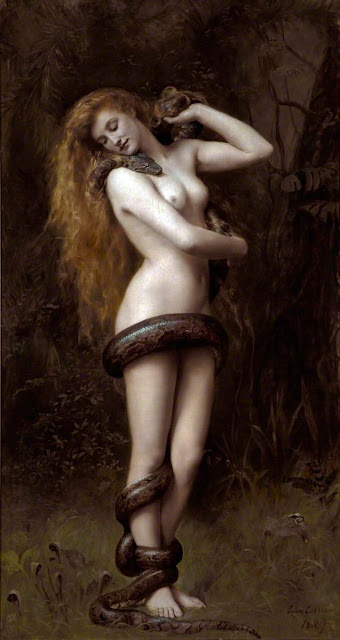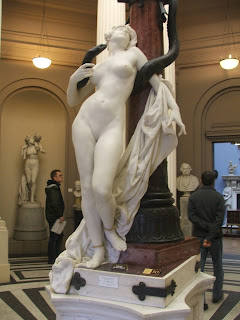TALKING 'BOUT THE BAD GIRLS: REVIEW OF 'FATAL ATTRACTION' EXHIBITION, THE ATKINSON, SOUTHPORT
TALKING ‘BOUT THE BAD GIRLS:
REVIEW OF ‘FATAL ATTRACTION: LILITH & HER SISTERS’ EXHIBITION AT
THE
I never cease to be impressed by the way in which the
Atkinson (a local authority-run museum and art gallery in
The Atkinson’s latest exhibition, curated by Dr Laura Eastlake from the English Department at Edge Hill University, draws on paintings, ceramics, sculpture, book illustrations (Aubrey Beardsley’s Salome) and film (Mata Hari, Cleopatra, Theda Bara as the ‘Vamp’) to explore how the idea of the femme fatale found its way from ancient mythology into modern popular culture.
John Collier, Artemis (c 1920) Photo Credit: Atkinson Art Gallery, Southport
The museum’s main gallery space has been transformed by painting it a decadent purple (more Milka than Cadbury’s), whilst cut-out Corinthian columns allude to the Classical origins of many of the women featured in the exhibition: Venus, Medea, Medusa, the Sirens, Helen of Troy and Cleopatra. However, this exhibition also goes beyond the Classical tradition, exploring the origins of the femme fatale in ancient Mesopotamian deities (Inanna, Ishtar, Astarte, Lilith) and the role of the femme fatale in Jewish tradition (Lilith, Eve, Salome, Delilah, Potiphar’s wife Zuleika). While the main focus is on figures from mythology, the exhibition also serves as a reminder that historical figures, from Cleopatra to Nell Gwyn, can be mythologised too.
William Henry Longmaid, Eve. Photo Credit: Atkinson Art Gallery, Southport
Much of the art is so striking that several children en route to the Lego exhibition in the adjoining room insisted on stopping to look at the paintings. But given the amount of ground covered in a relatively small space, the sheer number of mythological and historical characters under consideration here can feel a bit overwhelming. The exhibition is perhaps at its best when it encourages us to compare different representations of the same character, as in the cases of Lilith and Medea.
In common with several other pieces in this exhibition, John Collier’s Lilith (1887) was inspired by a literary work – Dante Gabriel Rossetti’s poem Eden Bower (1869) – a good reminder that Victorian art has often outlived the longwinded poetry which inspired it. Rossetti drew on the Talmudic tradition that Lilith was Adam’s first wife, who left Eden rather than be subservient to him: in the poem, she plots her revenge on Adam with her snake lover – taking on the form of the snake, she will return to Eden and trick Adam and his new wife into eating the forbidden fruit, knowing that God will cast them out.
John Collier, Lilith (1887). Photo Credit: Atkinson Art Gallery, Southport
Collier’s painting – the undoubted star in the Atkinson’s
permanent collection – presents a Lilith as a beautiful nude, her modesty
protected by the coils of a giant python.
There’s no real attempt to suggest that we might be in the
Dante Gabriel Rossetti, Lady Lilith (1868), Delaware Art Gallery
Collier’s painting is accompanied by a reproduction of Rossetti’s own take on the subject, Lady Lilith (1868), painted during exactly the same period when he was working on the Eden Bower poem. A bare-shouldered modern-day Lilith contemplates herself in a mirror, in a boudoir full of flowers and candles. The implication seems to be that she’s vain and self-absorbed, but hardly a sinister or vengeful figure (Rossetti’s friend Algernon Swinburne, the poet, commented on how indifferent she looked, demonstrating neither good nor evil impulses). The painting lacks any direct allusion to Lilith’s story; it has been suggested that it may have started life simply as a painting of a woman at her dressing-table, transformed into the character of Lilith as a result of Rossetti’s poetic fascination with the story.
The most anodyne femme fatale in the entire show is – interestingly enough – the work of a female painter. Evelyn de Morgan’s Medea (1863) is presented as an anaemic, winsome Pre-Raphaelite maiden, far removed from the exotic sorceress of the ancient sources (Euripides’s Medea and Apollonius’s Argonautica), Frederick Sandys’s painting (Birmingham Art Gallery) or Nancy Kovack’s portrayal of Medea as the Priestess of Hecate in the classic 1963 film version of Jason and the Argonauts. Without the title, I suspect that most viewers would find it difficult to identify this woman as Medea; once she’s been identified for us, we realise that she’s not carrying a Victorian port decanter, but a vial of poison with which she will saturate the dress and chaplet to be sent to Jason’s new bride, the princess Glauce. The exhibition suggests that Evelyn de Morgan sought to present Medea in a sympathetic light, as a wronged wife; such a portrayal may have struck a chord with Victorian women seeking to win the right to divorce an unfaithful or cruel spouse, or to win custody of their children. Perhaps the white doves and red roses on the floor in the painting are intended to symbolise the way in which Jason discarded Medea’s love in order to further his own status, having been offered the chance to marry a Greek princess rather than a so-called ‘barbarian’ from Colchis.
Nevertheless, de Morgan’s painting doesn't quite convince, and I think the reason for this is its failure to convey Medea’s anger at her unjust treatment by Jason. By contrast, Alphonse Mucha’s poster for Sarah Bernhardt’s production of Medea (1898), reproduced in the exhibition, manages to convey her anger with a blazing palette of oranges and yellows. Bernhardt’s Medea, clutching a dagger, seems startled by her own capacity for violence as she gazes at the body of one of her victims.
Alphonse Mucha, Medea (1898), poster for Sarah Bernhardt's production
Whilst the Victorian works provide the catalyst for the exhibition, it’s the modern pieces which prove to be the most thought-provoking: Carel Weight’s Medusa (1974), terrified by her own reflection in a shop window; Maisie Maud Broadhead’s Hero, sliding off the gallery wall and onto the floor as if it’s a liquid photograph; and the South African artist Johannes Phokela’s Candle Bathing (1997), a beautifully-lit take on Rubens’s Samson & Delilah - but with a black Samson.
Finally, a quick word on the Covid situation: for anyone nervous about visiting an art gallery post-lockdown, this is a good place to dip your toe in the water. The gallery layout is clear and uncluttered, and the one-way system makes it relatively easy to social distance whilst still getting up close to the art. The fact that the exhibition is free also encourages repeat visits.
And before I forget … my favourite fun fact from the
exhibition is that Nell Gywn used to refer to Louise de Kérouaille (her French
rival for Charles II’s affections) as ‘Squintabella.’
‘Fatal Attraction:
Lilith & Her Sisters’ is at the













Comments
Post a Comment